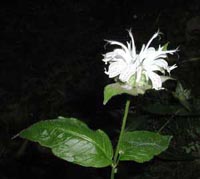Resource Library
Plant of the Week: Russell's Beebalm
The University of Arkansas System Division of Agriculture does not promote, support or recommend plants featured in "Plant of the Week." Please consult your local Extension office for plants suitable for your region.
Plant of the Week
Russell's Beebalm
Latin: Monarda russelliana

In an out-of-the-way nook in my shaded garden, grows a small member of the mint tribe, Monarda russelliana, Russell’s beebalm. It grows there because it was planted by nature’s hand, not my own.
I am fond of this little plant, not just for the handsome flowers that appear each spring, but because it tells a tale of botanical exploration, friendship and death.
Russell’s beebalm is one of the dozen species of wild bergamot’s found throughout much of North America. It occurs from southern Illinois to Texas, with the Arkansas River drainage making up a big part of its range. It grows about 2 feet tall with square stems and 2 and one-half inch long, opposite, fragrant leaves typical of the mints.
It is the earliest of the monardas to flower, with blooms usually appearing in my garden during the first half of May. The "flower" is a terminal cluster of blooms called a verticillaster that contains numerous, two-lipped white, spotted pink, flowers. The flower head is almost 3 inches across and a favorite of butterflies when in bloom.
This plant’s discovery resulted from the botanical exploration of Thomas Nuttall (1786-1859), the first botanist to explore Arkansas. Nuttall was an Englishman with a strong interest in natural history. He came to the United States in 1808 and made contact with Philadelphia luminaries who funded his exploration ventures.
The second of his three major trips was in 1819 as he tried to follow the expedition of Zebulon Pike (of Pike’s Peak fame) up the Arkansas River to the southern Rockies. His trip is recounted in his A Journal of Travels into the Arkansas Territory, first published in 1821 and reprinted many times, including recently by the University of Arkansas Press.
On May 1, he arrived at the garrison along the Arkansas River now called Fort Smith, which he described as consisting of two block houses with lines of cabins or barracks and home to about 70 men. The fort was established in 1817 to prevent war between the Osage and Cherokees Indians. Both tribes were being forced from their ancestral homelands to the western edge of the deciduous forest in Arkansas Territory and conflicts were inevitable.
At the fort, the 33-year-old Nuttall met Dr. Thomas Russell (1793-1819), a doctor in the employ of the garrison. The two men of science developed a friendship and botanizing together in the prairies around the river. At that time, Nuttall described the landscape as checkered with small mounds and peppered with widely scattered trees in a park-like setting. The prairie face of the region was maintained by the Indians who periodically torched the grass to provide better grazing for the deer, elk and buffalo on which they relied.
On May 3, they had strayed far enough afield that the men camped out but neither were able to sleep because a persistent mosquito attack kept them from slumber. During the next couple months, Nuttall often complained of the mosquitos, but at that time they were only thought to be a nuisance, not carriers of disease. He continued his travels up river, but by August was near death from what he described as "bilious fever."
Finally, in September, he made his way back to the fort where he discovered that "ague (malaria) and bilious fever (had) spread throughout the territory in a very unusual manner." His friend, Dr. Russell, and a missionary sent to minister to the Osage (about 100 of them also died) had "paid the debt of nature" and "sleep securely in the unhallowed earth."
Because of illness, Nuttall abandoned his plans to make the Rockies and returned to the United States. He landed the professorship of botany at Harvard and remained there until the wanderlust of travel called again in 1834. He joined the group headed west that blazed the Oregon Trail.
Bilious fever was a catch-all phrase in the early 19th century. Fevers evoked the kind of fear then that the word "cancer" does today; medicine had not yet grasped the "germ" theory and cures were unpredictable. You either got better or you didn’t. Probably the disease that swept through Arkansas that summer was Yellow Fever, caused by a mosquito borne virus that originally was introduced from Africa. Epidemics of the disease occurred periodically until the last outbreak in the United States took place in New Orleans in1908.
Monardas are easy plants to grow. The most common monarda seen in gardens is the mid-summer flowering M. didyma, which is an aggressive spreader in the border. Russell’s beebalm is more stayed in character and does not have the aggressive rhizomatous roots of it’s kin.
All do best in fertile, moist ground, but they are in no way finicky about this requirement. While my Russell’s beebalm grows in shade, it probably would be happier in brighter locations where the plant would produce a better show. It can be propagated easily by springtime division or by seed.
By: Gerald Klingaman, retired
Extension Horticulturist - Ornamentals
Extension News - July 16, 2004
The University of Arkansas System Division of Agriculture does not maintain lists of retail outlets where these plants can be purchased. Please check your local nursery or other retail outlets to ask about the availability of these plants for your growing area.